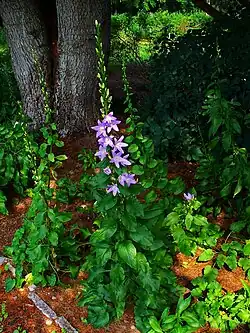Campanula pyramidalis
| Campanula pyramidalis | |
|---|---|

| |
| Scientific classification | |
| Kingdom: | Plantae |
| Clade: | Tracheophytes |
| Clade: | Angiosperms |
| Clade: | Eudicots |
| Clade: | Asterids |
| Order: | Asterales |
| Family: | Campanulaceae |
| Genus: | Campanula |
| Species: | C. pyramidalis
|
| Binomial name | |
| Campanula pyramidalis | |
Campanula pyramidalis, the chimney bellflower, is a species of Campanula, native to southeastern Europe in Italy and the western Balkans. Campanula means "bell-like" referring to the bell-shape of its flowers, while pyramidalis means pyramidal or conical, which refers to its conical shape.[1]
It is a short-lived perennial herbaceous plant growing up to 1.5 m tall. The leaves are broad ovate on the lower part of the stem, slender lanceolate on the upper part of the stem. The flowers are bell-shaped, blue, 3–4 cm diameter. The flowers are hermaphroditic, and the plant is self-fertile. It grows in many different soil types, and can handle a wide pH range. It prefers a sunny or partially shaded area.
It is grown as an ornamental plant for its scented flowers; several cultivars have been selected with flower colour ranging from white to dark blue.
-
Campanula pyramidalis in flower
References
- ^ Gledhill, David (2008). The names of plants. New York: Cambridge University Press. pp. 87& 322.
- Flora Europaea: Campanula pyramidalis
- Plants for a Future: Campanula pyramidalis
- Huxley, A., ed. (1992). New RHS Dictionary of Gardening 1: 494. Macmillan.